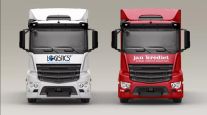Trucking, Logistics Acquisitions Expected to Continue in 2015
This story appears in the March 9 print edition of Transport Topics.
The hot 2014 trucking and logistics acquisitions market is likely to continue this year, driven by fleets’ need to secure capacity, rising economic expectations and a flood of available cash to pay for deals, analysts said.
“2014 was a continuation of the growth trend in recent years,” John Anderson, advisory director at private equity firm Greenbriar Equity Group, told Transport Topics. “Both buyers and sellers are saying ‘Wow! This is the time to do a deal.’ ”
Peter Troup, managing director at merger consultant EVE Partners, agreed.
“2014 was extremely active for both asset-based and non-asset-based companies,” Troup said. “We expect to see more of the same themes in 2015. Asset-based fleets are buying market share and capacity, with the goal of retaining drivers at a time of a chronic shortage.”
“There is a lot of activity,” Andy Ahern, CEO of Ahern & Associates, told TT. “I don’t know if it will reach everybody’s expectations.
“We thought the market was going to flatten out in ’15,” Ahern continued. However, the combination of an aging driver corps and restrictive federal regulations are forcing fleets “to look outside organic growth to get capacity.”
We are nearing the record level of deals that was set in 2007, Anderson said.
Standard & Poor’s Inc.’s Capital IQ, which compiles trucking acquisition activity, provided TT a report showing 86 trucking and logistics acquisitions in 2014. In 2007, the total was 90.
Anderson said buyers seek growth from both the economy and the sectors they serve, with particular attractiveness among refrigerated and retail-oriented dry van operators. Flatbed is challenged by energy sector weakness.
CRST International Inc., which ranks No. 24 onthe Transport Topics Top 100 list of the largest for-hire carriers in the United States and Canada, last week announced the most recent acquisition with the purchase of Pegasus Transportation Inc.
CRST said Louisville, Kentucky-based Pegasus offers the ability to add services such as temperature-sensitive shipments and automotive freight.
“We are always in search of adding companies to our portfolio that offer services which allow us to expand our capabilities,” said CEO Dave Rusch at CRST, which has made three acquisitions in two years.
Its move follows other early 2015 purchases, including Radiant Logistics buying Wheels Group Inc., Forward Air buying Towne Inc., and purchases by XPO Logistics and Saia Inc.
Also in recent weeks, two Japanese companies — Japan Post and Kintetsu World Express — have announced $6.2 billion of international logistics acquisitions.
“We are seeing significant activity in the non-asset-based area from both strategic and financial buyers,” Troup said.
Among the strategic buyers last year were XPO Logistics, which added multiple companies, and broker C.H. Robinson Worldwide Inc.’s Freightquote acquisition.
Strategic buyers seek to expand existing businesses, while financial buyers’ purchases aim to maximize profits, analysts explained.
A key factor in the valuation of asset-based acquisitions, Troup noted, is the buyer’s confidence that it can hold on to the seller’s drivers.
“Nobody has drivers,” said Ahern citing a current shortage and expectations of a worsening situation.
“The M&A market is thriving because it’s still hard to get drivers, and acquisitions are the easiest way for a carrier to grow,” said Jason Seidl, an analyst at Cowen & Co.
The cost of acquisitions is on the rise too.
“There is a very competitive market for high-value assets,” Troup said. “Valuations remain fairly high relative to what we saw three or four years ago.”
He said prices are a function of widely available cash for both types of buyers.
While the analysts stressed that transaction value is based on each deal’s particular characteristics, Troup gauged typical value of non-asset-based acquisitions at a multiple of nine to 11 times the seller’s earnings, before interest and taxes.
Anderson said asset multiples were around six and non-asset-based top 10 times.
Private equity companies are more geared to the non-asset-based side, such as logistics companies, because of the potential for higher returns, Troup said.
Asset-based acquisitions fetch lower prices, Anderson explained, because equipment-related depreciation and amortization costs are included.
Others were more conservative. Ahern said typical asset-based values were under five times EBITDA and no more than seven times for non-asset.
Ahern also noted changes in succession practices that affect M&A activity.
“We are seeing a lot of second- and third-generation people who are staying in the business or coming back,” he said, citing No. 20 C.R. England as an example of family management succession.
In recent years, some who founded fleets after industry deregulation in 1980 have chosen to sell because younger family members weren’t interested.
Ahern also said some company founders are transferring their firms to employees instead of selling them.




